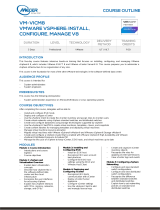
Contents
1 EVO:RAIL Management........................................................................................5
Access EVO:RAIL Management.............................................................................................................5
Create VMs.............................................................................................................................................5
Monitor VMs.......................................................................................................................................... 8
Monitor appliance health...................................................................................................................... 9
Add EVO:RAIL Appliances to an EVO:RAIL cluster.............................................................................10
Prerequisites.................................................................................................................................. 10
Procedure...................................................................................................................................... 10
Ongoing configuration........................................................................................................................ 11
Activating EVO:RAIL licenses......................................................................................................... 11
Localizing GUI................................................................................................................................12
Updating appliance software........................................................................................................ 12
2 EVO:RAIL Maintenance...................................................................................... 15
Access vSphere WebClient..................................................................................................................15
Logging and Events............................................................................................................................. 15
Events............................................................................................................................................. 15
vRealize Log Insight.......................................................................................................................15
Support Logs..................................................................................................................................16
Live Logging...................................................................................................................................16
Hardware replacement .......................................................................................................................16
Appliance shutdown............................................................................................................................16
3 Appendix A – VM size by guest OS ................................................................. 17
4 Appendix B — Security profile details ............................................................19
Risk Profile 1.........................................................................................................................................19
Risk Profile 2........................................................................................................................................ 19
Risk Profile 3........................................................................................................................................20
5 Appendix C: EVO:RAIL appliance shutdown or restart................................21
EVO:RAIL cluster shutdown................................................................................................................ 21
EVO:RAIL cluster restart ..................................................................................................................... 27
EVO:RAIL single appliance shutdown................................................................................................ 28
EVO:RAIL single appliance restart ..................................................................................................... 29
6 Getting help......................................................................................................... 31
Contacting Dell....................................................................................................................................31
3




















